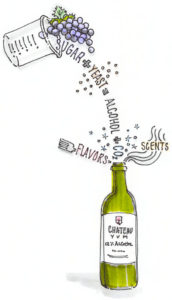Wine Basics Overview
![]()
Wine is defined as the fermented juice of freshly-harvested grapes. So like great cooking, it is:
 Ingredients plus Process (how it’s made) plus Art
Ingredients plus Process (how it’s made) plus Art
grapes + yeast ferment and (often) age skills, married with passion
Specifically, yeast fermentation converts the grape juice’s sugar into alcohol, and that’s wine—at least, that’s the scientific formula for making it:
Grape Sugar + Yeast = Ethyl Alcohol + Carbon Dioxide + Flavors & Scents
or, to get geeky: C6H12O6 + Yeast = 2 C2H5OH + 2 CO + Esters
Yikes! Science? I know, it looks scary but it’s really not so relax (with a glass of wine) and read on:
The above is the formula for wine, but will it be a good wine? And what is good wine? Pros often say a “good wine” is the one you like, and that’s true. But every able winemaker wants to ensure you’ll like the wine, so like a good cook, they skillfully tweak both the recipe and the process in to what is called “winemaking.” I’ve laid out the basic steps in the chart below.
How, When, Where? It makes a difference. – In ancient times, man used what was available and leak-proof—a clay amphora, animal skin sack, even a pit dug in the ground—for wine fermentation, storage and transport.
Nowadays there are lots of choices of containers in which to ferment, age and store the wine—from stainless steel tanks to wooden casks to egg-shaped concrete tanks, glass bottles and more. The choice of which vessel(s) to use, for which parts of the process, and for how long, all can affect the final style and quality of the wine. Who makes these choices? The Vintner, or winemaker, makes all these choices, and more, depending on the style of wine desired, and the condition of the grapes during each particular harvest year, or Vintage, the quality of which depends largely on the weather which is controlled, of course, by Mother Nature. Nature also makes an indelible imprint on the wine via the soil and climate in the each Vineyard region, often determining which grapes, or Varietals, will succeed there. Simply put, wine grapes, like any plant, are “picky” (pun intended) about their growing conditions! What’s great about these variables–which I refer to as the 4 V’s of wine, are often found right on the wine label or wine list entry. The individual lessons on each will show you how to identify them, and what they reveal about the wine in the bottle. That’s true sommelier savvy for sure!


